Technical Facilities
by Martin Willey
Thanks to Marcus Lindroos
Input to the computer is mainly by keypads on desks or computer panels (e.g. Ring Around The Moon, Space Brain). Kano has a slightly different desk to the normal design, from Missing Link onwards. Command Centre desks feature VDU screens.
Verbal commands can also be made: Koenig uses his commlock in Black Sun, Guardian Of Piri, Alpha Child (Jarak), Collision Course, The Bringers Of Wonder part 2; Helena talks to a communications post in Breakaway; Tony talks to door panels in The Beta Cloud.
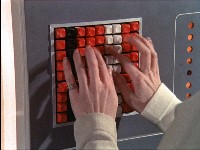
The standard Year 1 computer wall keyboard has 81 red, white and black keys arranged in a 9x9 pattern. They are supposedly used for "programming" the computer. The keys are unlabelled (the keyboard is used upside down in some episodes) There is no monitor for displaying the result of the data input (Kelly, Dr.Russell and Ted Clifford presumably have the psychic ability to read the computer's memory cells...). The slots at left resemble disk or memory card drives. The X5 computer panels above and below the keyboard do not appear in early Year 1 episodes. See more on keypad panel.
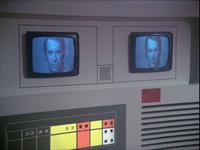
The "X3" computer panel is very common. The function keys control nearby audio/video devices, e.g. the living quarters video telephone monitors.
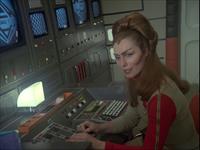
This keyboard (inherited from the UFO television series) was frequently used in Year 1. It only rarely appears in the Year 2 Eagle passenger modules. Here, Maya uses it to check the Eagle velocity.
Output in Year One is on rolls of paper like tciker-tape or check-out receipts (e.g. Black Sun, Ring Around The Moon, Space Brain), or by bleeping and flashing lights in meaningful sequences. In Year Two, rectangular 80-column IBM punch cards are printed out (e.g. Journey To Where, The Rules Of Luton). Standard A4 size printouts are also seen in Guardian Of Piri, Dragon's Domain so larger printers presumably exist. Images and photographs can also be output to glossy paper or transparencies, as in The Last Sunset.
Text may also be printed on screens, which may be accompanied by the computer voice (see above). Text displays are very slow, crude and black and white; graphics displays are similarly basic (sine waves or animated squiggles). The Main Mission/Command Centre "big screen" can show colour text and computer graphics although this feature is rarely used. Similar but smaller flat screen displays can be seen in other areas (Koenig's quarters, commander's office, laboratories) but they are comparatively rare.
The computer speaks regularly (Breakaway, Matter Of Life And Death, Black Sun, Earthbound, Another Time, Another Place, Guardian Of Piri, Force Of Life, The Infernal Machine, plus in Eagles in The Mark Of Archanon and All That Glisters). In Brian The Brain we are told the "Mark 10 Holographic Programming" Computer seen in Command Centre does not speak, which may be because it is a different computer from the one seen elsewhere on the base.
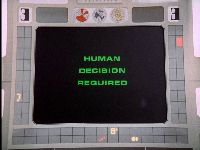
Standard screens, including the Big Screen in Main Mission, are video screens but for computer output they runs in terminal emulation. The terminal screen has similar characteristics to standard terminals from the 1970s to the 1980s such as the 1975 DEC VT52 (and still used in the DOS and Unix command shells as well as the Microsoft Windows HyperTerminal). It has a limited character set (ASCII with no graphics), slow typing (1970s terminals used 56k serial lines), and in Breakaway the Big Screen display text is clearly green screen. Green was the standard phosphor colour for early terminals, and still synonymous with computing in films like The Matrix (1999). From the mid 1980s white on black screens became available, which is usually seen in Moonbase Alpha. The screen is somewhat less than the standard 24 row by 80 column, but from the DEC VT100 onwards there were ANSI escape sequences for double height letters which is a near approximation. The font is Microgramma, created in 1952 and used extensively in Star Trek, 2001: A Space Odyssey and Gerry Anderson's UFO.
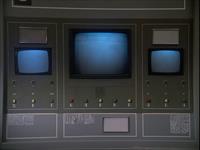
The most common computer monitor panel has one large and two small displays. The smaller monitors have three input ports for receiving data from e.g. medical sensors. The large screen is sometimes used as a videophone. There are 11 function keys in all (here labelled S,F,T,V,A,P,H,O,G,U,N) ; they are used for e.g. ending a video call or turning off monitors
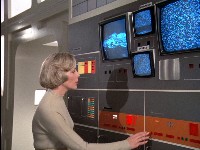
Main Mission uses a slightly different configuration, with two large and two small screens and only one loudspeaker grill. Here, we see Dr.Russell trying to restore the broken telemetry link to Parks' and Bannion's Eagle in Matter Of Life And Death. Although basic functions (power on/off, reset, answer/end video call) can be performed by pushing the square buttons below the monitors, it seems the computer displays are largely controlled from the adjacent panels.
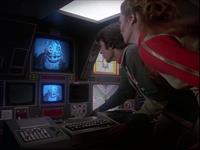
A third computer monitor configuration is used in the Year 2 Weapons Section and Voyager, Ultra probe cockpit sets. It consists of one large plus three small CRT monitors.
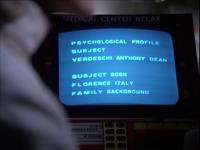
Alpha Computer users can display text and graphics on a wide range of CRT screens -- commlocks, communications posts, wall/desk-mounted screens or portable "relay" monitors such as the one pictured here.
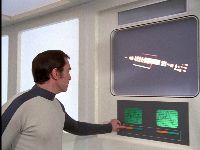
Some episodes feature a smaller version of the wall-mounted Main Mission/Command Centre "main screen". The flat screen control panel differs from episode to episode. Shown here is the unusual Breakaway Reconnaissance Section configuration. Koenig pushes the leftmost button to turn off the screen (the only time when we see this control panel being used for anything). The graphs on the small twin screen resemble modern operating system (e.g. Windows, Linux) CPU or computer memory usage displays.
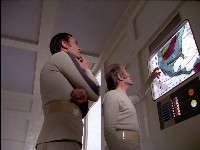
Here, Koenig and Bergman are examining a computer generated "radio map" of the Earth's surface in Another Time Another Place.
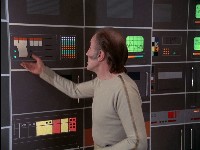
Although the standard Year 1 printer panel has four paper slots, only the one at lower left is used. The user pushes the red and white buttons to obtain a paper copy. The coloured lights at right possibly indicate computer network communications activity while the six vertical slots look like disk or memory card drives. More on print-outs
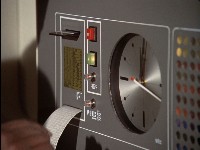
This version of the Year 1 printer panel also has a Metamec clock. In Another Time, Another Place, Koenig pushes the yellow button to turn off the Alpha navigation signal radio transmitter
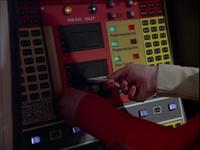
In Year 2, the checkout receipts were replaced with printout cards. The printer panel is only seen in the Command Centre.
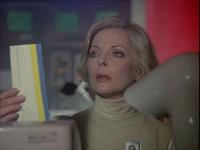
The Year 2 printout card initially appeared in Into Infinity -- it's actually an early 1970s IBM 80-column punch card. They were introduced in 1928 by IBM. By the 1970s they were old-fashioned, but continued to be used until the 1980s. Punch cards are used for computer input, but the Moonbase Computer prints them out as output for humans to read.
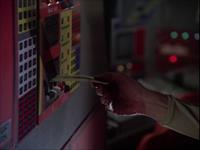
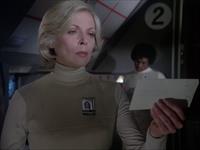
In the Life Support Section in Seed Of Destruction. Punch cards are used as input for computers, but in 1999 computers print them out as results for humans- Helena is able to read results from the punched holes.
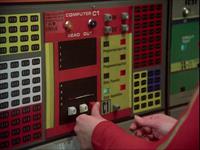
Computer "Read out". "Programme" is a British English spelling, but in computing British English follows the American convention of "program". In both British and American English, the verb form ("programming") conventionally has a double-m.
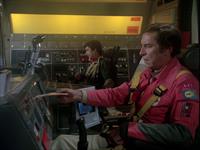
The same print-out card appears in the Eagle in Space Warp.
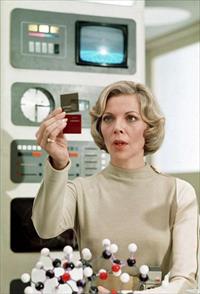
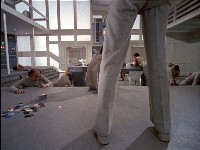
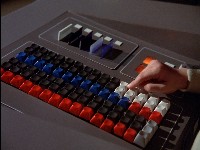
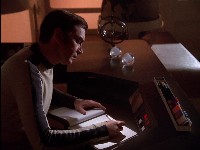
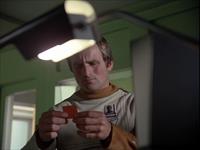
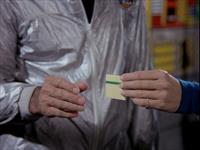
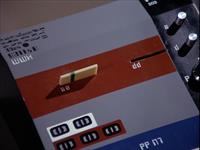
We also see coloured plastic rectangles, often stored in the Pio Manzu Kartell ash tray. In Koenig's desk are a number of slots in which these pieces of plastic are inserted. We don't see them in use except for year 1 publicity photos of Helena, in The Bringers Of Wonder part 1 when Kander has his photos stored on them, and The Bringers Of Wonder part 2 when Helena's white noise recording is played from the card.
These look and act very much like flash memory cards. Invented in 1980, the PCMCIA 1.0 PC card was first introduced in 1990; memory sticks were introduced in 1998 and the memory cards for digital cameras in the 2000s. When the series was first shown, even floppy disks were large (8 inches; the 5 inch format was first introduced in 1976 and the 3.5 inch format in 1981). If they had used these plastic cards instead of paper and punch cards, the series would have future-proofed itself.
Copyright Martin Willey
Thanks to Marcus Lindroos